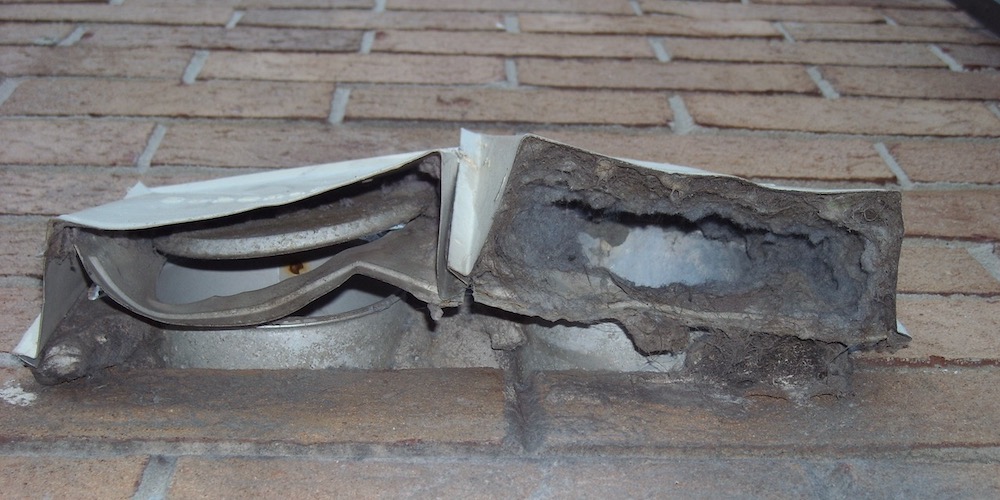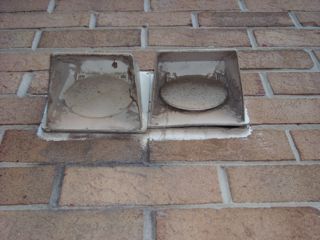An Easy to Fix Air Flow Problem That Can Save Energy – and Your Life

As I’ve mentioned here before, I live in a 40 year old condo that’s a good example of what happens when you build something without understanding the principles of building science. I’ve previously written about the crawl space problems in one of our buildings and the basement problems in my building, as well as my proposed remedy to fix the basement. I’m on the board of our owners’ association and am doing what I can to make things better here, to the extent that our budget allows.
Recently, one of our owners had a problem with their dryer not venting properly, and that led me to go around  and look at the wall caps on most of our buildings. All the buildings with 2 bedroom units in them have dryer vents that exit through the back wall. The photos above and at right (the same vents from two angles) are typical of what I saw on my tour.
and look at the wall caps on most of our buildings. All the buildings with 2 bedroom units in them have dryer vents that exit through the back wall. The photos above and at right (the same vents from two angles) are typical of what I saw on my tour.
That’s two dryer vent wall caps side-by-side. The one on the left is crushed so the flapper has almost no space to move. The one on the right seems to have no flapper. Both have little space for air to move out of the duct when the dryer’s running, and also don’t do a good job of stopping outside air – and critters – from getting into the dryer vent when it’s not running.
Restricting the air flow in a dryer vent causes several problems:
- The dryer runs longer.
- It uses more energy.
- Lint can collect in the duct, and the duct gets hotter. This creates a fire hazard.
The more restricted the air flow, the more extreme those problems will be.
The good news is that the solution is simple. All you have to do is replace the wall cap to improve air flow, cut drying time and energy usage, and reduce your fire hazard. The photo shown at right is from the other side of the same building where I took the above photos. You can see that both flappers are closed, and both have plenty of room to open widely to enhance air flow. Wall caps are only a few bucks and even if you pay someone to install it for you, it shouldn’t set you back too much.
that the solution is simple. All you have to do is replace the wall cap to improve air flow, cut drying time and energy usage, and reduce your fire hazard. The photo shown at right is from the other side of the same building where I took the above photos. You can see that both flappers are closed, and both have plenty of room to open widely to enhance air flow. Wall caps are only a few bucks and even if you pay someone to install it for you, it shouldn’t set you back too much.
Of course, the wall cap is probably only part of your dryer’s air flow problem. As with just about any duct system, the duct between the dryer and the wall cap probably has crimps, kinks, sharp turns, and extra length that all cut down the air flow, too. If your wall cap looks like the one at top, though, fix it right away.
See the followup to this article: 4 Products for Enhancing Air Flow in Dryer Vents.
Allison A. Bailes III, PhD is a speaker, writer, building science consultant, and the founder of Energy Vanguard in Decatur, Georgia. He has a doctorate in physics and is the author of a popular book on building science. He also writes the Energy Vanguard Blog. You can follow him on Twitter at @EnergyVanguard.
Comments are closed.
This Post Has 12 Comments
Comments are closed.

Very good points Allison, and
Very good points Allison, and just to add in a few more; as part of your regular yearly maintenance you should use a shop vac to clean up lint caught in the dryer filter area
Use said shop vac & clean out any built up lint from the exterior
Pull the dryer out disconnect the hose from both the back of the dryer & the exterior connection and vacuum out any built up lint from both areas
Before reassembling – If you have one of those cheep plastic vent hoses replace it with a metal one
Excellent advice, Sean.
Excellent advice, Sean.
Wow, great tips from Allison
Wow, great tips from Allison and Sean. Thanks, guys. Now I just have to talk someone into doing this chore at my house! Okay, in truth, I mostly dry my clothes on a line outside – it’s Santa Barbara after all!
You’re welcome, Alexandra.
You’re welcome, Alexandra. You shouldn’t have any air flow or fire hazard problems with a clothes line! And if you live in Santa Barbara, you probably don’t have any problems at all because it’s a perfect place with a perfect climate and perfect people, right? ;~)
I’ve seen too many of those.
I’ve seen too many of those. However, watch out for any dryers venting through the roof. My 4 inch duct had 1 inch of lint all the way around the perimeter. I had more dust in the house than one could imagine. It’s imperative to clean these stacks often!
I didn’t mention in the
I didn’t mention in the article, Sam, but the building that I live in has dryer vents through the roof. Since we’re on the first floor, that’s a long run to the roof, and yes, we do have to clean it often.
I live in an apartment
I live in an apartment building where the laundry rooms of four apartments share an interior corner, and the dryers vent into a shared stack of some sort so that when any of my three neighbors runs their dryer, hot damp air comes into my laundry room through my dryer. Whenever I know about one of my neighbors doing laundry, I turn my dryer on to its longest timed setting with no heat, just to keep the nasty air out of my apartment. I don’t actually know where the dryer exhaust is supposed to leave the building or the condition of the vent cap(s).
Whoa, Lee, you should get the
Whoa, Lee, you should get the management to check that out immediately. It could be common venting with clogged duct, causing air to move back into your dryer. You could install a back-flow preventer (flapper that opens away from but not toward your dryer) to keep the other dryers from venting into your unit. Does your dryer seem to take a long time to dry your clothes?
What a terrible waste of energy though, even without the heat.
I haven’t noticed excessive
I haven’t noticed excessive drying time in my dryer. A back-flow preventer seems like a really good idea. Is that something I can get at my local home improvement store? I had been assuming I would have to try to adapt an exterior vent flap to fit inside the exhaust hose, and couldn’t figure out how that could work.
The apartment management is aware that dryers blow into other apartments, but I haven’t asked them if they’ve had anyone clean lint out of the exhaust stacks.
I suppose I should mention
I suppose I should mention that there is no gas supply to any of the apartments, so CO2 is not part of the concern.
Lee, you may be able to find
Lee, you may be able to find one at the local home improvement store. If not, you can always go to an HVAC supply house and pick up one there.
Stay tuned for more good dryer vent info, as I’ve got another article in the pipeline with some good product recommendations – and nasty photos of bad dryer vents.
My dryer vent runs through my
My dryer vent runs through my crawl space. Moisture condenses on the inside of the dryer duct resulting in lint sticking to the walls the length of the duct. I’ve made a little half moon shaped piece of wood, slightly smaller than the duct, on the end of long wood dowel rod. Whenever my wife says the clothes are taking too long to dry, I pull dryer cap off, push the half moon through the duct, round side up and scrape the top, then when I’m as far in as I can go, I rotate it, scrape the bottom, and pull all the lint out. Saved a friend from having to buy a dryer when I loaned him my gadget.